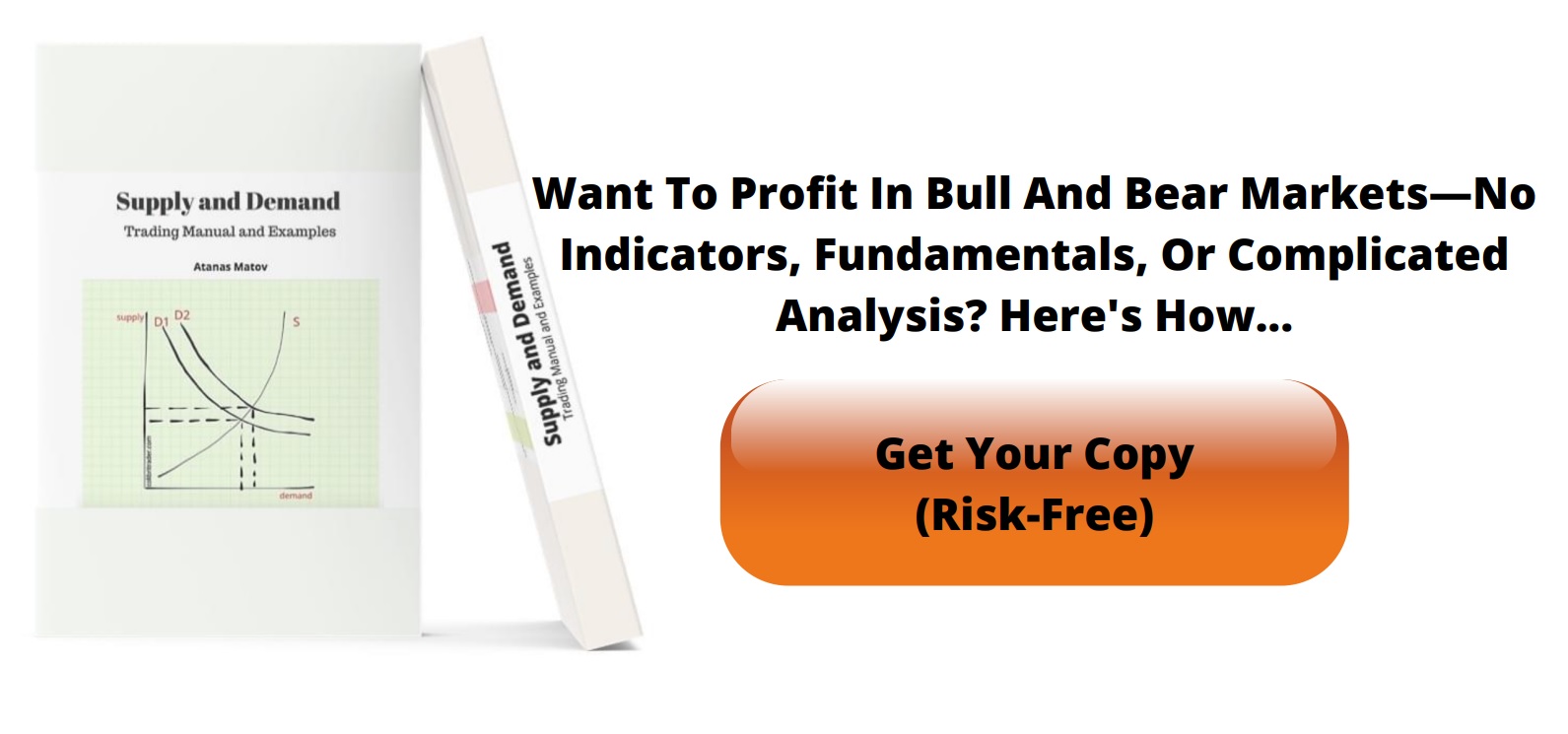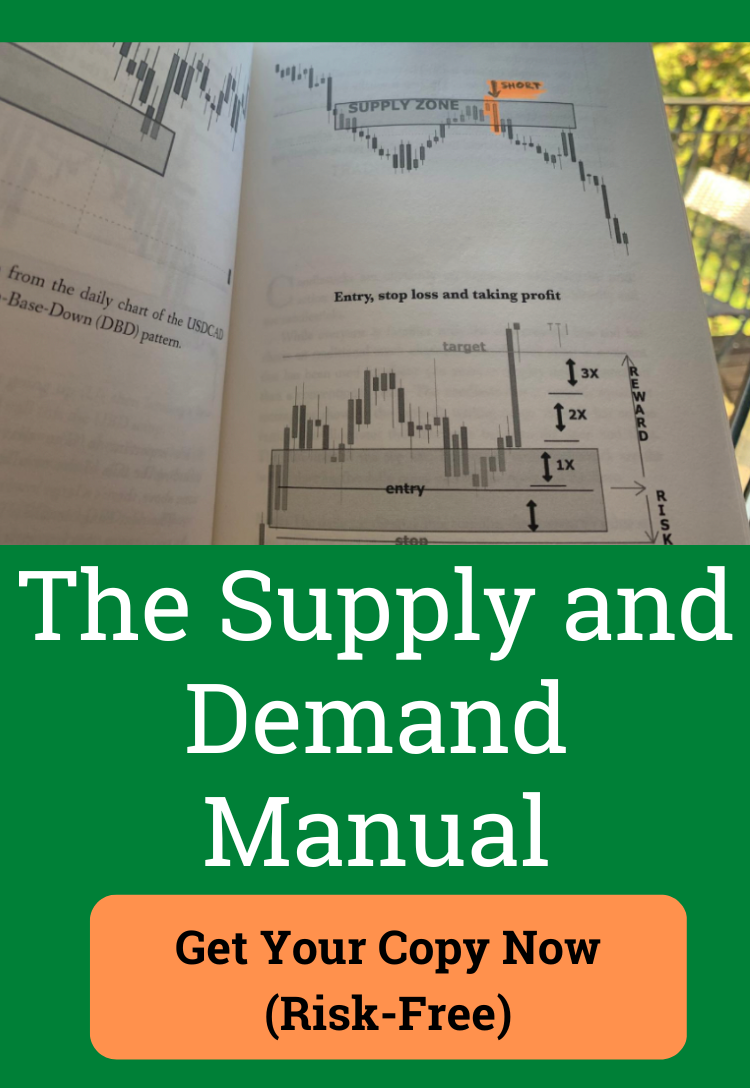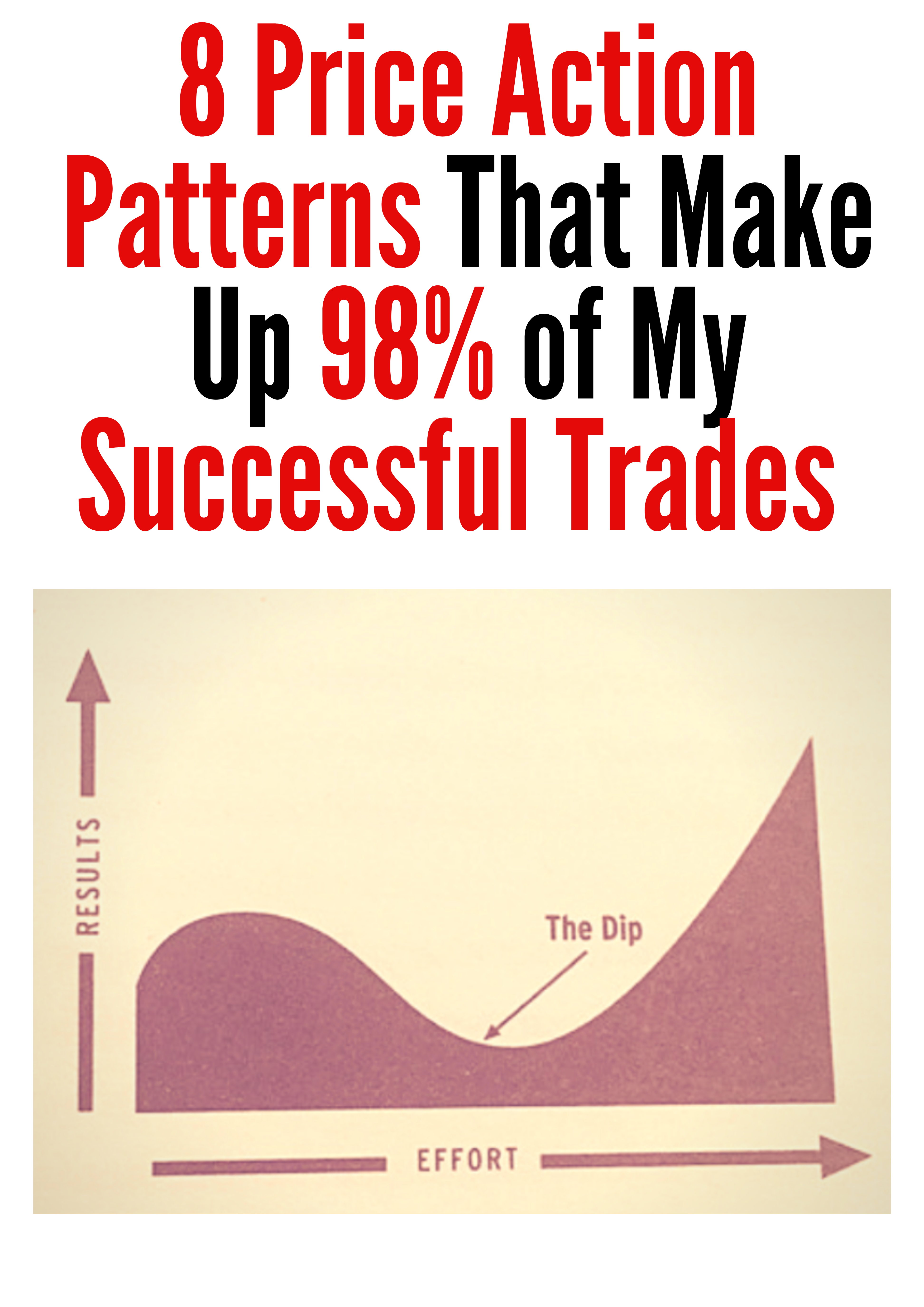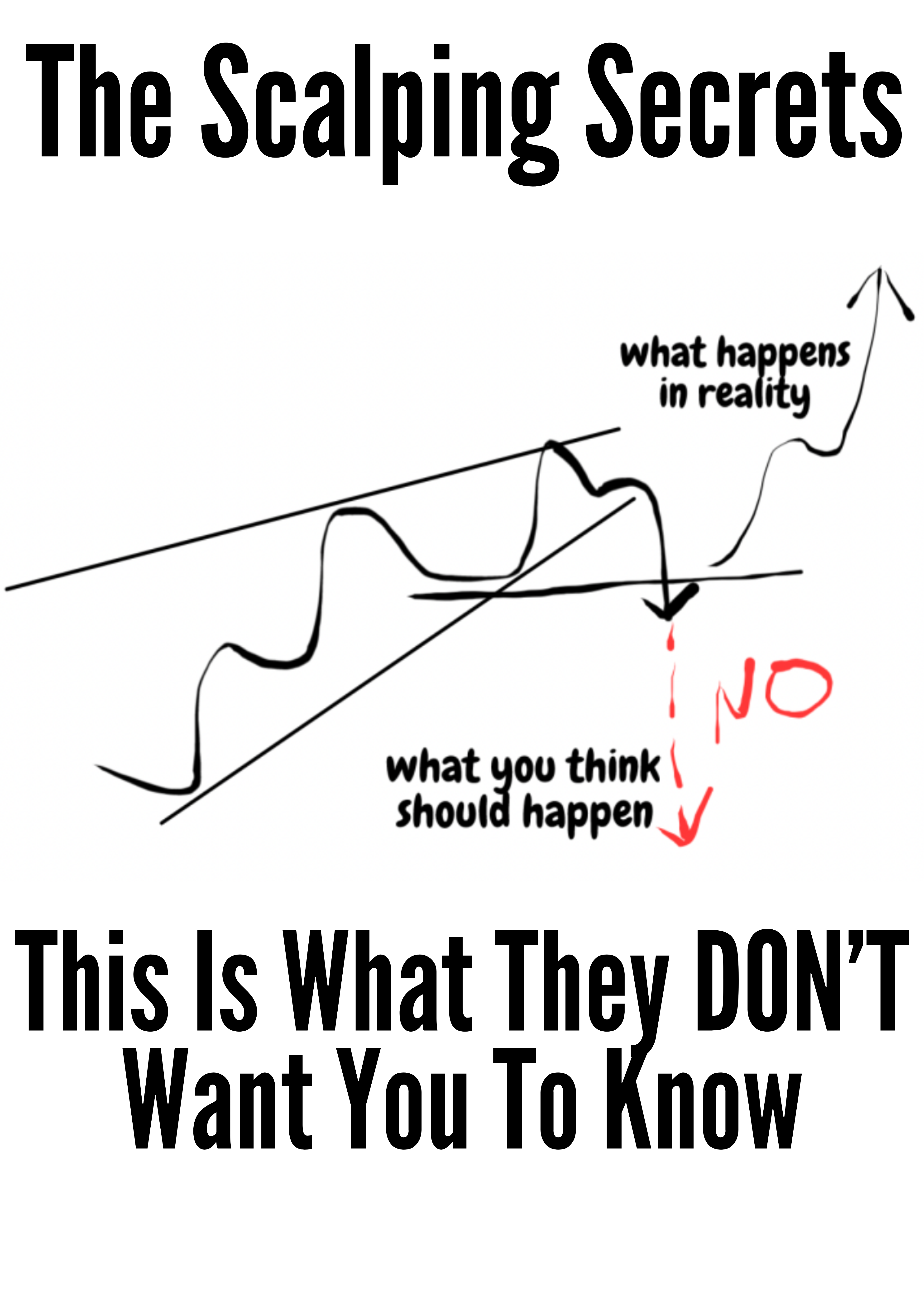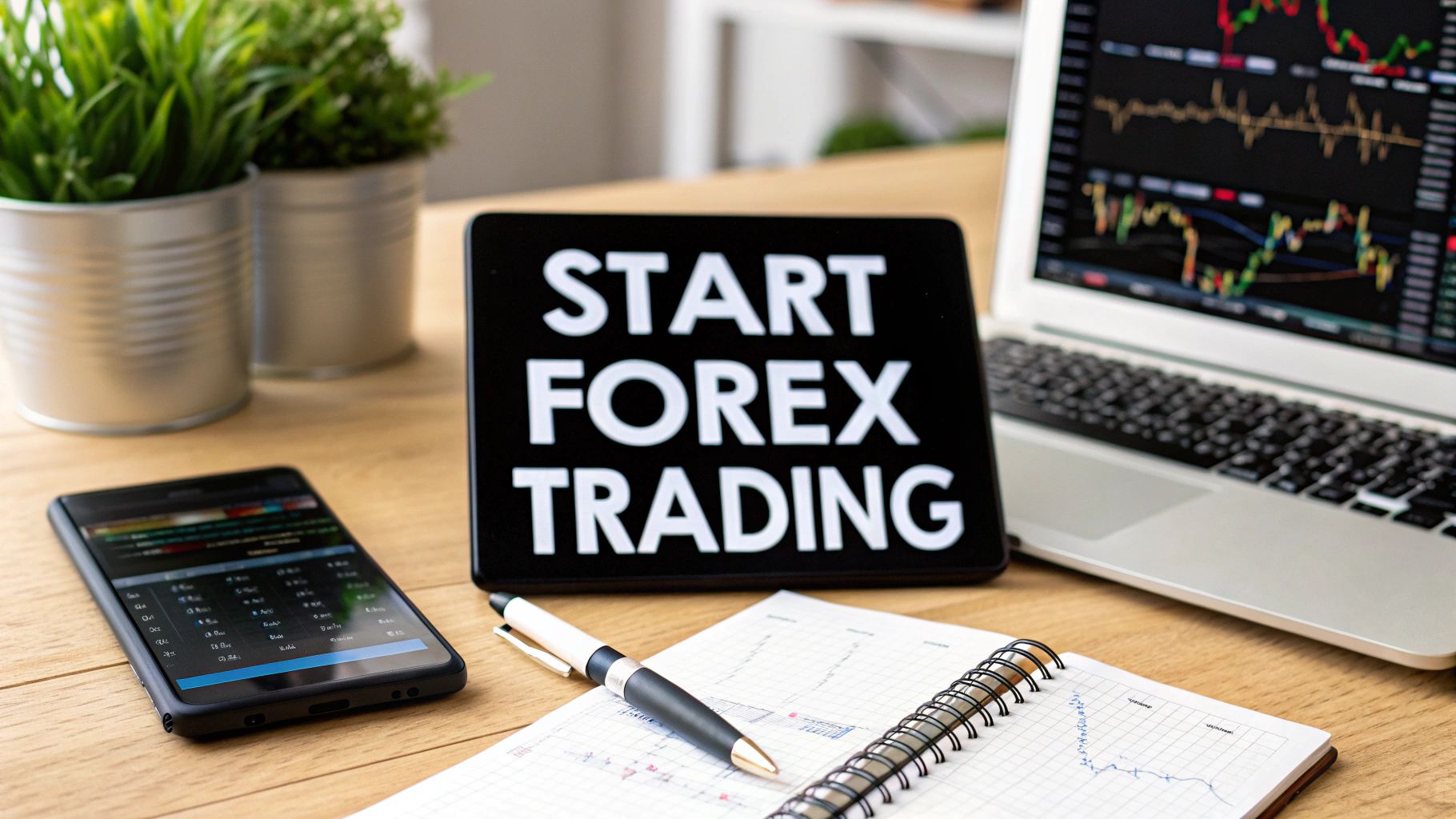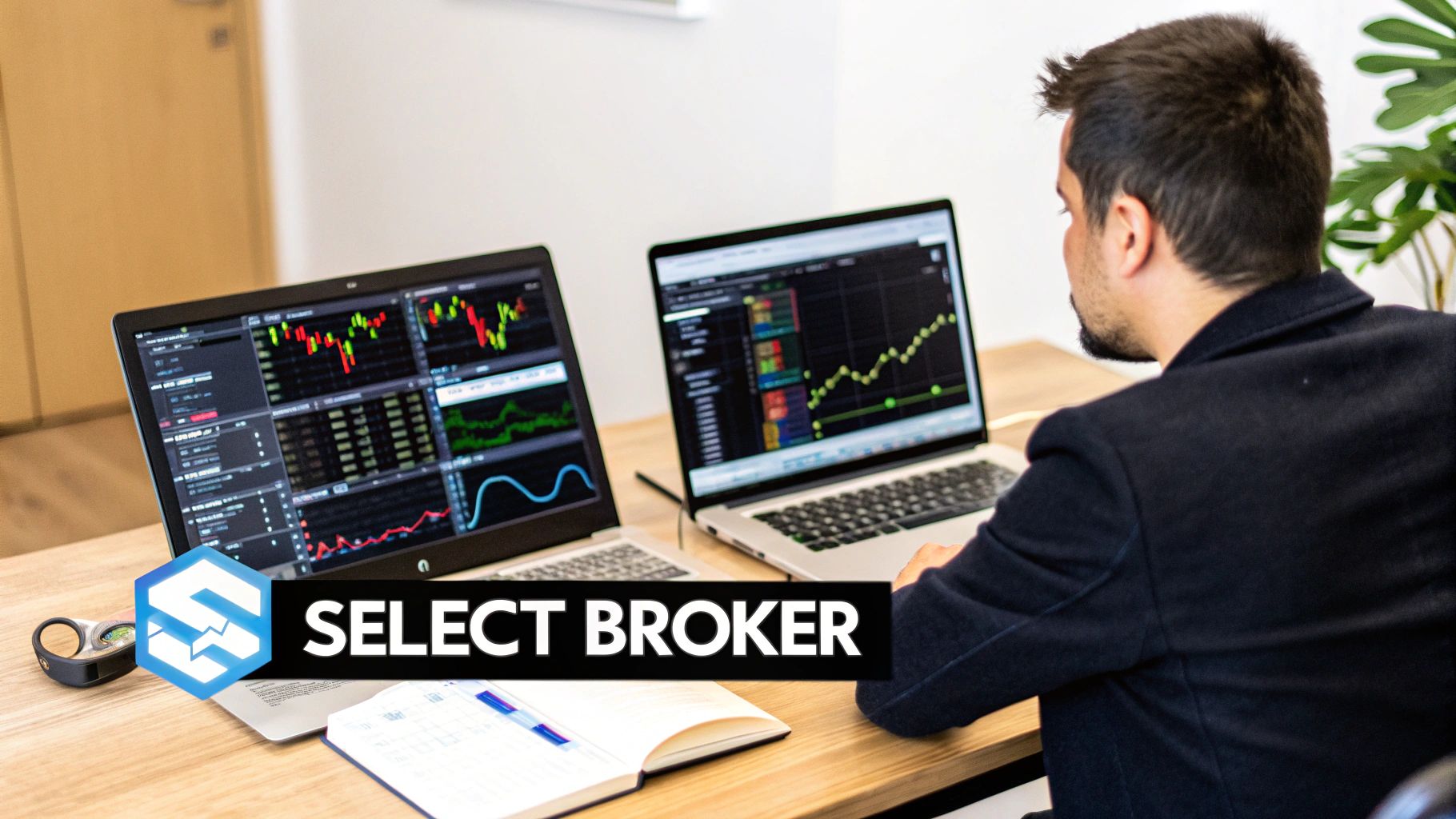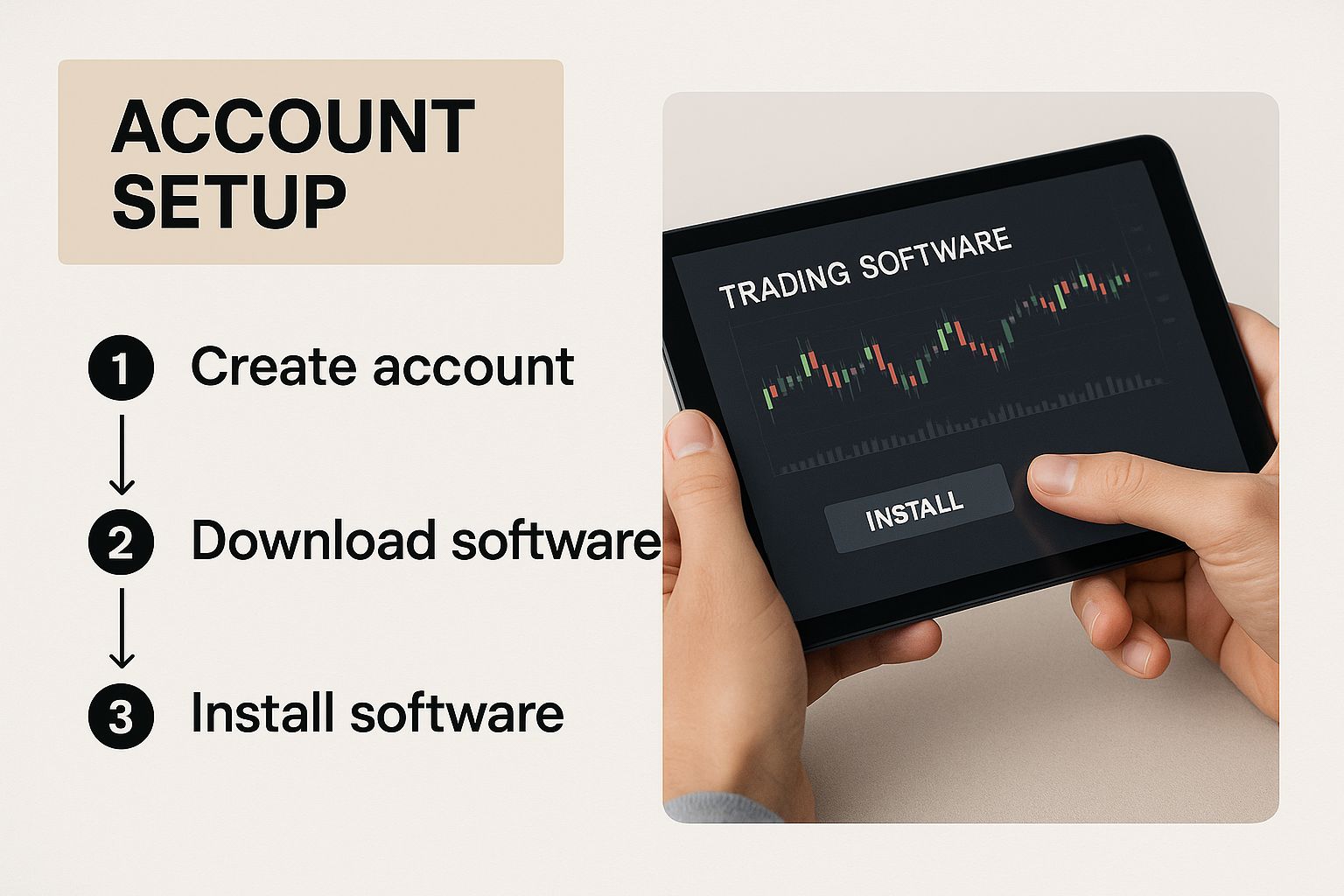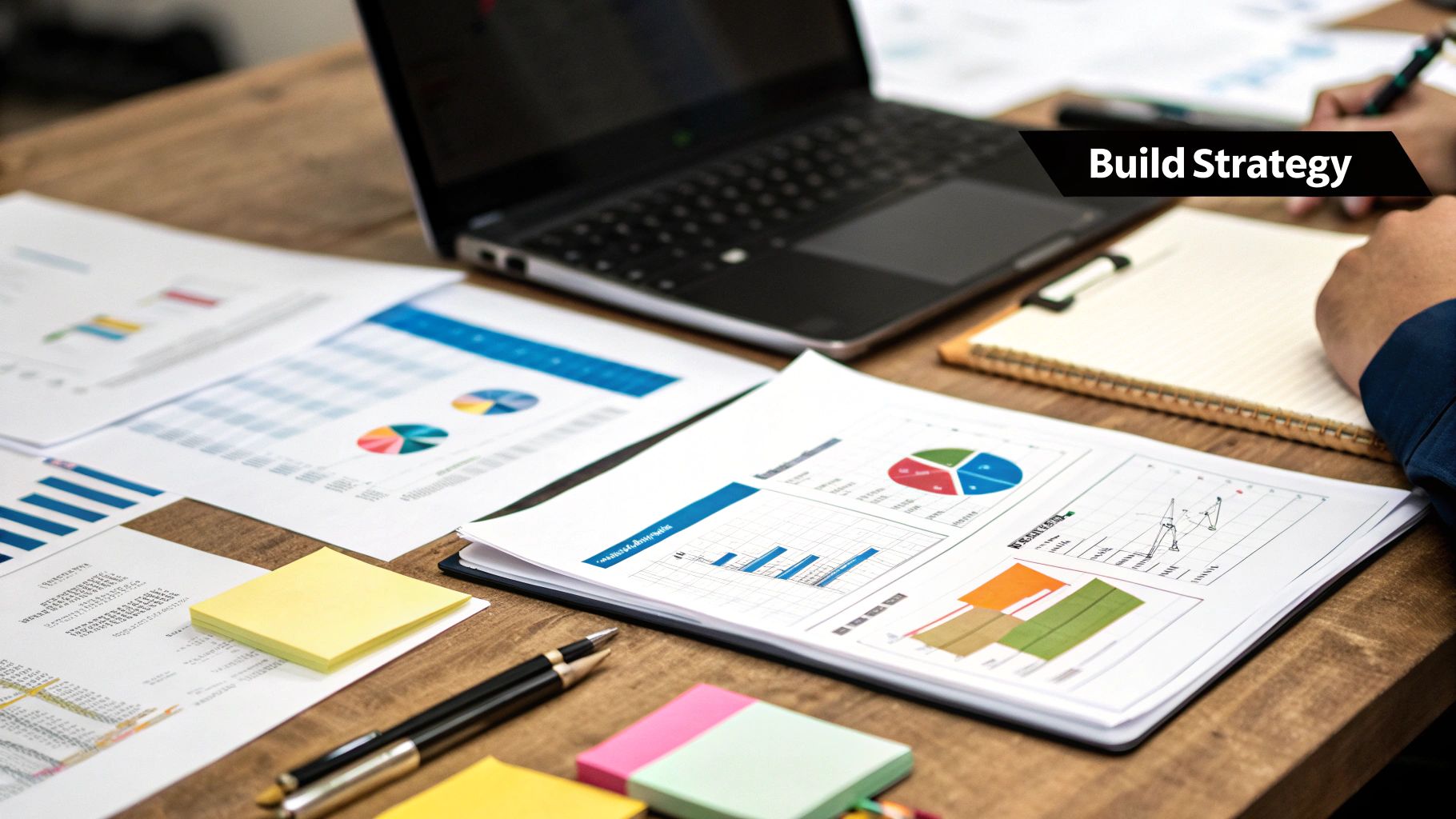How to Start Forex Trading A Realistic Guide
So, you’re ready to dip your toes into the world of forex trading. It can feel a bit like learning a new language and navigating a foreign country all at once. Before you even dream of placing that first trade, you’ve got to build a rock-solid foundation.
This isn't about memorizing textbook definitions. It’s about truly understanding the landscape you're about to step into.
The foreign exchange market is the biggest financial playground on the planet—a decentralized global space where currencies are swapped 24/5. Its sheer size brings incredible opportunities, but also very real risks that you absolutely must respect.
To put it in perspective, the daily turnover in the global forex market hit a staggering $7.6 trillion in 2022. That mind-boggling figure is what provides the liquidity for traders like us to get in and out of positions easily. You can dive deeper into these numbers by checking out the full forex trading statistics.
Your First Steps into the World of Forex Trading
Before you risk a single dollar, you need to get the basics down cold. It’s time to learn the lingo.
Think of it this way: a carpenter who doesn’t know the difference between a nail and a screw isn't going to build a very sturdy house. In trading, getting these core concepts wrong will lead to equally disastrous results.
Here's a quick rundown of the essential terms you'll see everywhere. Master these, and you'll have a much clearer picture of what's happening on your charts.
Essential Forex Terms You Need to Know
This isn't just jargon; these are the tools you'll use every single day to measure, plan, and execute your trades.
| Term | What It Means for Your Trades | Practical Example |
|---|---|---|
| Currency Pair | You're always trading one currency's value against another. The first is the "base" currency, and the second is the "quote." | In EUR/USD, you’re betting on whether the Euro will get stronger or weaker compared to the US Dollar. |
| Pip | This is the smallest unit of price movement. It’s how you measure your profit or loss. | If the EUR/USD pair moves from 1.0750 to 1.0751, that’s a one-pip move. |
| Lot Size | This is simply the size of your trade. Standard, mini, and micro lots determine how much each pip is worth. | A standard lot (100,000 units) means one pip is worth about $10. A micro lot (1,000 units) means one pip is worth about $0.10. |
| Leverage | This is borrowed capital from your broker. It lets you control a much larger position with a small amount of your own money. | With 100:1 leverage, you can control a $100,000 position with just $1,000 from your account. It magnifies both your wins and your losses. |
Getting a firm handle on these concepts is your first real step toward becoming a trader. They are the building blocks of every strategy and every decision you'll make.
The Non-Negotiable Prerequisites
Beyond the vocabulary, there are a few practical things you absolutely must have in place. Without these, you're setting yourself up for a very short and painful trading journey.
- A Reliable Internet Connection: The market moves in a blink. A laggy or unstable connection can mean missed entries, delayed exits, and costly mistakes. Seriously, don't skimp on this.
- Sufficient Starting Capital: You'll see brokers advertising tiny minimum deposits. Ignore them. Trading with an underfunded account makes proper risk management completely impossible. You need enough cash to absorb the market's normal swings without getting a margin call.
- The Right Mindset: Trading is 90% a mental game. You need discipline, patience, and the emotional strength to handle losses. And trust me, losses are an inevitable part of the business.
Key Takeaway: Real success in forex doesn't come from a magic indicator or some "can't-lose" robot. It's built on a solid understanding of how the market works, a disciplined mindset, and the right tools to execute your plan. Your first steps aren't about making money; they are about learning how not to lose it. This initial phase of education and prep is the most important investment you will ever make.
Choosing the Right Forex Broker for Your Goals
Picking a forex broker is one of the first, and most important, decisions you'll make in your trading career. It’s a bigger deal than most new traders realize. You’re not just choosing a platform; you’re choosing your primary partner in the markets. The right one gives you a secure and fair environment to execute your strategy. The wrong one can sabotage you from day one.
This goes way beyond just grabbing the one with the flashiest ads or the biggest sign-up bonus. The very first filter, the absolute deal-breaker, is regulation. Trading with an unregulated broker is like handing your money to a total stranger and just hoping they give it back. It's a risk you can't afford to take.
Why Regulation is Non-Negotiable
Reputable regulatory agencies aren't just there for show. They enforce strict rules on how brokers handle your money, ensure fair pricing, and give you legal recourse if things go wrong. If your broker goes bust, regulation is what stands between you and losing everything.
I only consider brokers supervised by top-tier authorities. You should, too. These are the big ones:
- Financial Conduct Authority (FCA) in the United Kingdom
- Cyprus Securities and Exchange Commission (CySEC) in Cyprus
- Australian Securities and Investments Commission (ASIC) in Australia
Working with a broker under one of these watchdogs is the absolute baseline for protecting your capital. It’s the first question you should ask and the first thing you need to verify on their website. No excuses.
Comparing the Features that Actually Matter
Once you’ve weeded out the unregulated players, it's time to dig into the details that affect your daily trading. This is where you find a broker that fits your specific style.
First up is the trading platform. This is your command center—where you'll analyze charts and place every single trade. Most brokers offer MetaTrader 4 (MT4) or its newer sibling, MetaTrader 5 (MT5). They're the industry workhorses for a reason, known for powerful charting and massive support for automated trading (Expert Advisors). Some brokers have their own proprietary platforms, which can look slicker but might lack the huge community and tools that come with MT4/MT5.
Next, you have to get a handle on the real cost of trading. This isn't always obvious and comes down to a mix of spreads and commissions. The spread is the tiny price difference between buying and selling a currency pair, and it's how most brokers make their money. Commissions are separate, fixed fees you pay on each trade, and you'll usually find them on accounts that offer tighter spreads.
Trader Tip: Don't get suckered in by "zero commission" marketing. Brokers always get their cut. Usually, those commission-free accounts just have wider spreads, which can end up costing you more, especially if you trade frequently. Do the math for yourself.
The foreign exchange market is massive. Its size was pegged at roughly $2.4 trillion in 2023 and is expected to grow to $3.5 trillion by 2032. As more traders jump in, choosing a solid partner becomes even more critical to navigate this space. You can dig into the numbers and trends in the full research report on the foreign exchange market.
The Critical Role of Leverage and Risk
Leverage lets you control a large position with a small amount of capital. It’s a powerful tool, but it’s absolutely a double-edged sword. It can amplify your profits, but it will magnify your losses just as fast. A broker screaming about offering insane leverage like 500:1 or 1000:1 isn't doing you a favor—they're encouraging you to blow up your account.
A responsible broker promotes sound risk practices. In fact, top-tier regulators often cap the leverage available to retail traders for exactly this reason. To see just how vital this is, check out our guide on how solid risk management helps you stay in the game. Your ability to manage risk is what will keep you trading tomorrow, and the day after that.
A Checklist for Choosing Your Broker
Before you even think about depositing a single dollar, run through these questions. The answers will tell you everything you need to know.
| Factor to Check | What to Ask Yourself | Why It Matters |
|---|---|---|
| Regulation | Is this broker regulated by a top-tier authority like FCA, CySEC, or ASIC? | This is your number one defense against fraud. It ensures your funds are kept separate and protected. |
| Trading Costs | What's the typical spread for the pairs I trade? Are there commissions? How much will it really cost me? | High costs are a direct drag on your profits. You need total transparency here. |
| Platform | Does the platform (MT4, MT5, proprietary) feel right for me? Is it reliable and intuitive? | A clunky or slow platform is a recipe for missed trades and costly execution mistakes. |
| Customer Support | Is support available when I need them (24/5)? Can I get a real person on the line quickly? | When a live trade goes wrong, you don’t have time for chatbots or email queues. You need help now. |
| Account Types | Do they have an account type that matches my starting capital (e.g., micro, standard)? | The right account helps you manage risk in a way that’s appropriate for your budget. |
Don't rush this decision. Do your homework, compare your top options side-by-side, and choose a partner that truly has your security and long-term success in mind.
Building Experience in a Risk-Free Demo Environment
So you've picked a broker. The temptation is to throw some money in and start trading for real. Don't. Your next move, and arguably one of the most important, is to open a demo account.
Think of it as your personal trading simulator. It's a risk-free training ground where theory crashes into reality. This is where you build the raw muscle memory needed for successful trading, all without the financial gut-punch of those inevitable beginner mistakes.
A demo account mirrors a live trading platform, fed with real-time market data, but you're trading with virtual money. It's your chance to get a feel for the software, click every button, and understand the mechanics of placing a trade before a single real dollar is on the line.
Your First Steps in the Demo Environment
Getting started is pretty simple. Once your broker sends over your demo login, your only goal is to get comfortable with the trading interface, which will likely be MetaTrader 4 or its successor, MT5. Don't just sit there staring at the charts—you need to actively engage with the software.
Here’s a practical checklist to get you started:
- Open and Close a Trade: Find a major currency pair, like EUR/USD, and smash that "buy" button. Now, figure out how to close the position. Do it again, but this time, place a "sell" order.
- Set Your Risk Parameters: Open another practice trade. This time, you must attach a stop-loss (SL) and a take-profit (TP) order. Learn how to drag these levels on the chart or punch them in manually.
- Play with Lot Sizes: Practice opening trades with different position sizes. See how a micro lot (0.01) feels versus a mini lot (0.10). Watch how it changes your virtual profit and loss. It’s a completely different feeling.
This initial phase of just messing around is absolutely critical. You need to execute these core functions without a second thought, because when real money is involved and the market is moving fast, you won't have time to think.
Crucial Insight: The biggest mistake I see traders make is treating the demo account like a video game. If you treat that $50,000 virtual balance like Monopoly money, you’ll build reckless habits that will completely destroy your live account later. Trust me on this.
Treat Your Demo Trading Like a Business
To get any real value out of this, you have to trade your demo account with the same discipline you'd use with real cash. That means setting hard rules for yourself and, most importantly, tracking everything.
Start a trading journal from day one. Seriously. It can be a simple spreadsheet or a physical notebook where you log every single practice trade.
Here's what I track for every trade:
- Date and Time: When did you enter?
- Currency Pair: What market were you trading?
- Entry & Exit Prices: The exact price points for your entry, stop-loss, and take-profit.
- Reason for Entry: Why this trade? Was it a specific chart pattern, a news event, a signal from your strategy? Write it down.
- Outcome: The result, both in pips and virtual dollars.
- Notes and Reflections: What went right? What went wrong? What did you learn?
Journaling forces you to move from random clicking to a systematic approach. You're building a dataset of your own performance, which is priceless for finding your recurring mistakes and sharpening your strategy.
The goal here isn't just to practice clicking buttons. It's to practice being a trader. Set a clear, tangible objective for yourself, like achieving two straight months of virtual profitability before you even think about going live.
Developing Your First Practical Trading Strategy
Stepping into the forex market without a clear plan is like trying to navigate a dense jungle without a map. You might get lucky for a little while, but sooner or later, you'll end up lost. Your trading strategy is that map—a set of rules you define yourself that guides every single decision and keeps raw emotion out of the driver's seat.
Every choice you make, from entry to exit, should be dictated by your strategy, not a gut feeling or a hot tip. This is what truly separates consistent traders from gamblers. Before you can build one, though, you need to understand the two main schools of thought that drive all market analysis.
Fundamental vs. Technical Analysis: A Comparison
Every strategy is built on one of two core analytical approaches. While some seasoned traders blend them, it's critical to understand them individually first. One looks at the "why" behind price moves, and the other focuses purely on the "what."
This table breaks down the core differences to help you see which might be a better fit for your personality and goals.
| Aspect | Fundamental Analysis | Technical Analysis |
|---|---|---|
| Core Focus | Economic, social, and political forces that drive supply and demand. | Chart patterns, trends, and historical price data. |
| Primary Tools | Economic calendars, news reports, GDP data, interest rate decisions. | Price charts, trend lines, support/resistance levels, indicators. |
| Time Horizon | Better suited for long-term investing and position trading. | Ideal for short to medium-term trading (swing, day, scalp). |
| Key Question | Why is the market moving? | What is the price doing right now? |
Many new traders find technical analysis more approachable. It offers clear, visual cues for when to enter and exit trades without needing a deep background in global economics. For that reason, we'll focus there.
Building a Simple Price Action Strategy
One of the most effective and cleanest ways to start is with price action trading. This is a pure form of technical analysis. You're making all your decisions based on the movement of price itself, often without any fancy indicators cluttering up your charts.
Your goal is to learn to read the "story" the chart is telling. Let's walk through building a basic, rules-based strategy with a real-world feel.
Imagine you’re looking at the EUR/USD chart.
First, you need to identify the prevailing trend. Zoom out to a higher timeframe, like the 4-hour or daily chart. Is the price generally making higher highs and higher lows (an uptrend), or lower lows and lower highs (a downtrend)? Let's say it's in a clear uptrend. Your first rule is now set: Only look for buying opportunities. Simple.
Next, you have to find a strategic entry point. Now you can zoom into a lower timeframe, like the 1-hour chart, to fine-tune your entry. In an uptrend, the price doesn't just shoot up in a straight line; it breathes. It pulls back. You're looking for the price to pull back to an area of support—a price level where buyers have stepped in before to push prices higher. Your second rule: Enter a buy trade only when the price retests a confirmed support level.
Finally, and most importantly, you must set clear exit points. You do this before you even think about clicking "buy." You place a stop-loss order just below that support level. This is your non-negotiable exit if the trade turns against you. You also set a take-profit target at the next logical resistance level, which is an area where sellers might overwhelm buyers. Your third rule: Always define your stop-loss and take-profit before entering the trade.
This structured approach, from initial setup to defining your rules, is the backbone of disciplined trading.
A simple, rules-based system like this one eliminates the guesswork. You aren't just buying because you "feel" the market is going up. You're patiently waiting for a specific, pre-planned setup to appear on the chart.
A strategy isn't just about finding good entries. A complete strategy tells you what market to trade, what direction to trade, when to get in, and most importantly, when to get out—for both a win and a loss.
To formalize these rules into a robust document, take a look at this great guide on how to make a forex trading plan in 10 steps. It provides an excellent framework for adding the necessary detail and structure to your personal strategy.
The real purpose of your first strategy is to build discipline. It forces you to be patient. It trains you to wait for your ideal conditions. Over time, you can refine it and make it more complex, but the simple habit of following your own rules is the single most valuable skill you can develop as a trader.
Mastering Risk Management and Trading Psychology
If there’s one single thing that separates the few consistently profitable traders from the 90% who fail, this is it. You can have the best strategy in the world, but it's completely worthless if bad risk management blows up your account. It's equally useless if your emotions make you abandon your plan at the worst possible time.
Getting a handle on risk and psychology isn't just a step in learning to trade forex; it's the very foundation of survival and longevity in this business.
The raw power of the forex market is staggering. The Bank for International Settlements (BIS) put daily turnover around $6.6 trillion back in 2019, an amount that makes stock exchanges look tiny. When you're playing in an arena that massive, personal discipline is the only thing standing between you and a catastrophic loss.
This is where you stop being a chart-gazer and become a true risk manager.
The Cornerstone of Survival: The 1-2% Rule
The most critical rule in risk management is brutally simple: never risk more than 1% to 2% of your trading capital on a single trade. I'm not kidding. This isn't a suggestion—it's the law of survival for a trader.
Following this rule means you could suffer a string of 10, 20, or even 30 losing trades and still have enough capital to stay in the game.
Let’s get practical. On a $2,000 account, risking 1% means your maximum loss on any one trade is just $20. That might not sound exciting, but that's precisely the point. It keeps your losses emotionally insignificant, which frees you up to focus on executing your strategy correctly, not agonizing over one trade's outcome.
Trader's Takeaway: Your goal isn't to be right every single time. It's to make sure you're still trading when your winning setups finally appear. Small, manageable losses are just the cost of doing business.
Calculating Your Position Size Correctly
So, how do you actually enforce the 1-2% rule? It all comes down to calculating your position size based on your stop-loss, not a gut feeling. Your position size is just the number of lots (standard, mini, or micro) you trade.
Here's how it plays out in a real-world scenario:
- Determine Your Risk in Dollars: With a $2,000 account and a 1% risk rule, your max risk is $20.
- Define Your Stop-Loss in Pips: Your price action strategy tells you to place a stop-loss 25 pips away from your entry on a EUR/USD trade.
- Calculate the Required Pip Value: You need to find a position size where a 25-pip loss equals your $20 risk. The formula is simply: Risk in Dollars / Stop-Loss in Pips = Value Per Pip.
- Find the Position Size: So, $20 / 25 pips = $0.80 per pip. A standard mini lot (0.10) on EUR/USD is worth about $1 per pip, and a micro lot (0.01) is worth $0.10. To get a pip value of $0.80, you would trade 8 micro lots (0.08).
This quick calculation ensures that if your stop is hit, you lose exactly what you planned to. No surprises, no oversized hits to your account.
Conquering the Psychological Battlefield
The market is an absolute master at exploiting your emotional weaknesses. Nearly every trader battles the same two demons: fear and greed. These feelings lead to destructive behaviors that can sabotage even the most brilliant trading plan. To really get to the core of the mental game, you should explore the fundamental concepts behind the psychology of trading, as it's a massive piece of the puzzle.
Here are some of the most common psychological traps I see:
- FOMO (Fear of Missing Out): You see a currency pair ripping higher and you jump in late, terrified you'll miss the rest of the move. This is a classic recipe for buying the exact top, right before it reverses.
- Revenge Trading: After taking a loss, you feel a burning desire to "get your money back." You immediately force another trade—often bigger and riskier—to try and erase the pain of the last one. This rarely ends well.
- Analysis Paralysis: After a few losses, you become too scared to pull the trigger. You see perfect setups according to your strategy, but you're frozen with fear, watching them play out perfectly without you.
The only way to cure these emotional hijacks is with unwavering discipline. You have to trust the trading plan you built in a calm, objective state more than you trust your feelings in the heat of the moment. Stick to your rules, period. This is the discipline that turns a hopeful amateur into a professional trader.
Common Questions on Starting Forex Trading
As you get closer to pulling the trigger on your first real trades, it’s completely normal for a few nagging questions to pop up. You’ve done the work, but maybe some doubts are lingering. It's a feeling every trader has had.
Let's walk through some of the most common questions I get from traders who are right where you are now. Getting straight answers isn't just about ticking boxes; it's about building the real, durable confidence you need to trade properly.
How Much Money Do I Realistically Need to Start Forex Trading?
This is the big one, and the honest answer isn't a simple number. Sure, you'll see brokers advertising that you can open an account with $100, but I strongly advise against even trying. It's a recipe for disaster.
Why? Because with a balance that small, you can't manage risk properly. And risk management is everything in this game. A single loss could wipe out a huge chunk of your capital, sending you into a panic and leading to terrible, emotionally-fueled decisions.
A much more sensible starting point is somewhere in the $500 to $2,000 range. This isn't a random figure. An account of this size gives you the breathing room to:
- Trade micro lots (0.01), which keeps your risk on any single trade incredibly small—often just a few dollars.
- Absorb a string of losses without blowing up your account. Losing streaks happen to everyone, even pros.
- Concentrate on making good trading decisions based on your strategy, not on the fear of losing money.
Starting with too little capital is like trying to build a house with only a handful of bricks. You just don't have the materials to succeed.
Is Forex Trading Genuinely Profitable for Beginners?
Yes, it absolutely can be. But let’s be crystal clear about what that takes. Trading isn't a lottery ticket. The unfortunate truth is that most beginners lose money, not because the market is rigged, but because they try to skip the hard work.
For a new trader, profitability comes directly from a deep commitment to three things:
- Real Education: Truly understanding how the market moves, mastering your chosen strategy, and internalizing risk management principles.
- Iron-Clad Discipline: Following your trading plan and risk rules without exception, especially when fear or greed starts whispering in your ear.
- Extreme Patience: Waiting for the A+ setups your strategy dictates, instead of forcing low-quality trades because you're bored or anxious.
The traders who find success are the ones who treat this like a serious business from day one. They have a plan, they follow rules, and they keep detailed records.
The market rewards discipline, not daring. Beginners who rush in, overleverage their accounts, and trade emotionally are essentially gambling. Those who approach it with the mindset of a professional give themselves a fighting chance to become profitable over time.
What Are the Biggest Mistakes New Forex Traders Make?
If you want to get ahead, one of the smartest things you can do is study the mistakes others make. New traders almost universally fall into the same handful of traps that wreck their accounts and their confidence.
The single most destructive mistake, by far, is risking too much per trade. It's the expressway to a zero balance. Right behind that is trading with no clear strategy, which is the same as just guessing.
Other classic blunders include:
- Revenge Trading: After a loss, you feel that sting and immediately jump back in to "make it back." This is pure emotion, and it almost always digs a deeper hole.
- Ignoring the Stop-Loss: Entering a trade without knowing exactly where you'll get out if you're wrong. Your stop-loss is your most important piece of safety equipment.
- Rushing to a Live Account: Ditching the demo account before you've proven you can be consistently profitable in a risk-free environment. Patience in the demo phase pays huge dividends later.
Just by consciously avoiding these few mistakes, you're already putting yourself lightyears ahead of the crowd.
Ready to build the discipline and skills needed to avoid these mistakes? At Colibri Trader, we provide a clear, no-nonsense path to mastering price action trading. Start your journey and discover your trading potential with us today.

